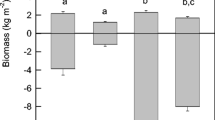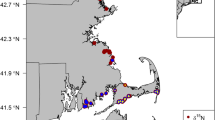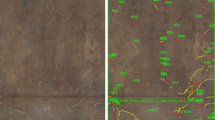Abstract
The monthly variations of below- and aboveground biomass of Spartina alterniflora were documented for a south Louisiana salt marsh from March 2004 to March 2005, and in March 2006 and 2007. The annual production rate above- and belowground was 1821 and 11,676 g m−2, respectively (Smalley method), and the annual production rate per biomass belowground was 10.7 g dry weight−1, which are highs along the latitudinal distributions of the plant’s range. The average root + rhizome/shoot ratio (R&R/S) was 2.6:1, which is lower than the R&R/S ratios of 4 to 5.1 reported for Spartina sp. marshes in the northeastern US. The belowground biomass increased from July to September and fluctuated between October and November, after which it declined until February when the growing season began. The belowground biomass was dominated by rhizomes, which declined precipitously in spring and then rose to a seasonal high in the month before declining again as the late summer rise in inflorescence began. Over half of the root biomass in a 30-cm soil profile was in the upper 10 cm, and in the 10- to 20-cm profile for rhizomes. The maximum March biomass above- and belowground was four to five times that of the minimum biomass over the four sampling years. The net standing stock (NSS) of N and P in live biomass aboveground compared to that in the belowground biomass was about 1.7 times higher and equal, respectively, but the NSS of N and P for the live + dead biomass was about six times higher belowground. The average nitrogen/phosphorous molar ratios of 16:1 aboveground is in agreement with the often tested N limitation of biomass accumulation aboveground, whereas the 37:1 belowground ratio suggests that there is an influence of P on R&R foraging for P belowground. Some implications for management and restoration are, in part, that salt marshes should be evaluated and examined using information on the plant’s physiology and production both below- and aboveground.







Similar content being viewed by others
References
Blum, L., and R.R. Christian. 2005. Belowground production and decomposition along a tidal gradient in a Virginia salt marsh. In The ecomorphology of tidal marshes, eds. S. Fagherazzi, M. Marani, and L. K. Blum, 47–74. Washington, D.C.: American Geophysical Union.
Conner, R., and G.L. Chmura. 2000. Dynamics of above- and belowground organic matter in high latitude macrotidal saltmarsh. Marine Ecology Progress Series 204:101–110.
Dame, R.F., and P.D. Kenny. 1986. Variability of Spartina alterniflora primary production in the euhaline North Inlet estuary. Marine Ecology Progress Series 32:71–80.
Darby, F.A., and R.E. Turner. 2008. Below- and aboveground biomass of Spartina alterniflora: Response to nutrient addition in a Louisiana salt marsh. Estuaries and Coasts (in press).
Fitter, A. 2002. Characteristics and function of root systems. In Plant roots: the hidden half, eds. Y. Waisel, A. Eshel, and U. Kafkafi, 15–32. New York, Basel: Marcel Dekker, Inc.
Gallagher, J.L. 1974. Sampling macro-organic matter profiles in salt marsh plant root zones. Soil Science Society of America Proceedings 38:154–155.
Gallagher, J.L. 1983. Seasonal patterns in recoverable underground reserves in Spartina alterniflora Loisel. American Journal of Botany 70:212–215.
Gallagher, J.L., and D.M. Seliskar. 1976. The metabolism of senescing Spartina alterniflora. Annual Meeting Botany Society of America, New Orleans Abstract. p. 34.
Gill, R.A., and R.B. Jackson. 2000. Global patterns in root turnover for terrestrial ecosystems. New Phytologist 147:13–31.
Good, R.E., and B.R. Frasco. 1979. Estuarine evaluation study; a four year report on production and decomposition dynamics of salt marsh communities: Manahawkin marshes, Ocean County, New Jersey. Report to New Jersey Department of Environmental Protection, Division of Fish, Game, and Shellfisheries, Trenton, New Jersey, 105 pp.
Good, R.E., N.F. Good, and B.F. Frasco. 1982. A review of primary production and decomposition dynamics of the belowground marsh component. In Estuarine comparisons, ed. V.S. Kennedy, 139–158. New York: Academic Press.
Gross, M.F., M.A. Hardisky, P.L. Wolf, and V. Klemas. 1991. Relationship between aboveground and belowground biomass of Spartina alterniflora (Smooth Cordgrass). Estuaries 14:180–191.
Kaswadji, R.F., J.G. Gossenlnk, and R.E. Turner. 1990. Estimation of primary production using five different methods in a Spartina alterniflora salt marsh. Wetlands Ecology and Management 1:57–64.
Kirby, C.J., and J.G. Gosselink. 1976. Primary production in a Louisiana gulf coast Spartina alterniflora marsh. Ecology 57:1052–1059.
Koerselman, W., and A.F.M. Meuleman. 1996. The vegetation N:P ratio: a new tool to detect the nature of nutrient limitation. Journal of Applied Ecology 33:1441–1450.
Lana, P. da Cunha, C. Guiss, and S.T. Disaro. 1991. Seasonal variation of biomass and production dynamics for above- and belowground components of a Spartina alterniflora marsh in the euhaline sector of Paranaguá (SE Brazil). Estuarine, Coastal and Shelf Science 32:231–241.
McIntire, G.L., and W.M. Dunstan. 1976. Nonstructural carbohydrates in Spartina alterniflora Loisel. Botanica marina 19:93–96.
Mendelssohn, I.A., K.L. Mckee, and W.H. Patrick Jr. 1981. Oxygen deficiency in Spartina alterniflora roots: Metabolic adaptation to anoxia. Science 214:439–441.
Morris, J.T. 1991. Effects of nitrogen loading on wetland ecosystems with particular reference to atmospheric deposition. Annual Review of Ecology and Systematics 22:257–279.
Ornes, W.H., and D.I. Kaplan. 1989. Macronutrient status of tall and short forms of Spartina alterniflora in a South Carolina salt marsh. Marine Ecology Progress Series 55:63–72.
Schubauer, J.P., and C.S. Hopkinson. 1984. Above- and belowground emergent macrophyte production and turnover in a coastal marsh ecosystem, Georgia. Limnology and Oceanography 29:1052–1063.
Smalley, A.E. 1959. The role of two invertebrate populations, Littorina irrorate and Orchelimum fidicinium, in the energy flow of a salt marsh ecosystem. Ph.D. thesis, University of Georgia, Athens.
Smith, K., R.R. Good, and N.F. Good. 1979. Production dynamics for above-belowground components of a New Jersey Spartina alterniflora tidal marsh. Estuarine Coastal Shelf Science 9:189–201.
Stout, J.P. 1978. An analysis of annual growth and productivity of Juncus roemerianus Sheele and Spartina alterniflora Loisel in coastal Alabama. Ph.D. dissertation, North Carolina State University, Raleigh.
Stroud, L.M. 1976. Net primary production of belowground material and carbohydrate patterns of two height forms of Spartina alterniflora in two North Carolina marshes. Ph.D. Dissertation, North Carolina State University, Raleigh.
Turner, R.E. 1976. Geographic variations in salt marsh macrophyte production: a review. Contributions in Marine Science 20:47–68.
Turner, R.E., and J.G. Gosselink. 1975. A note on standing crops of Spartina alterniflora in Florida and Texas. Contributions in Marine Science 19:113–118.
Turner, R.E., E.M. Swenson, and C.S. Milan. 2001. Contrasting organic and inorganic content in recently accumulated salt marsh sediments. In Concepts and controversies in tidal marsh ecology, eds. M. Weinstein, and D.D. Kreeger, 583–595. Dordrecht, The Netherlands: Kluwer Academic Publishers.
Turner, R.E., E.M. Swenson, C.S. Milan, J.M. Lee, and T.A. Oswald. 2004. Below-ground biomass in healthy and impaired marshes. Ecological Research 19:29–35.
United States Environmental Protection Agency. 2002. Methods for evaluating wetland conditions: vegetation-based indicators of wetland nutrient enrichment, Office of Water, U. S. Environmental Protection Agency, Washington, DC. EPA-822-R-02-024.
Valiela, I., J.M. Teal, and N.Y. Persson. 1976. Production and dynamic experimentally enriched salt marsh vegetation: belowground biomass. Limnology and Oceanography 21:245–252.
Verhoeven, J.T.A. 1996. Nitrogen- or phosphorus-limited growth in herbaceous, wet mire vegetation: Relations with atmospheric inputs and management regimes. Trends in Ecology and Evolution 11:494–497.
Visser, Y.M., and C.A. Sasser. 2006. The effect of multiple stressors on salt marsh end-of-season biomass. Estuaries and Coasts 29:331–342.
White, D.S., and B.L. Howes. 1994. Translocation, remineralization, and turnover of nitrogen in the roots and rhizomes of Spartina alterniflora (Graminae). American Journal of Botany 81:1225–1234.
Whittaker, R.H. 1975. Communities and ecosystems, 2nd edition. New York: Macmillan.
Acknowledgments
We thank J. Baustian, A. Darby, J. M. Lee, C. Milan, T. A. Oswald, J. Spicer, and E. M. Swenson for their assistance in the field sampling and laboratory support and L. Blum for her inspired mentoring. Two anonymous reviewers made many helpful comments on a draft manuscript. Support was provided by the NOAA Coastal Ocean Program MULTISTRESS Award No. NA16OP2670 to Louisiana State University and a Louisiana Board of Regents Fellowship to F.A.D.
Author information
Authors and Affiliations
Corresponding author
Rights and permissions
About this article
Cite this article
Darby, F.A., Turner, R.E. Below- and Aboveground Spartina alterniflora Production in a Louisiana Salt Marsh. Estuaries and Coasts: J CERF 31, 223–231 (2008). https://doi.org/10.1007/s12237-007-9014-7
Received:
Revised:
Accepted:
Published:
Issue Date:
DOI: https://doi.org/10.1007/s12237-007-9014-7




